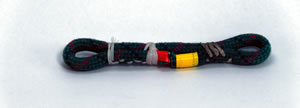

We principally looked at three means of seizing an eye without splicing-basting, round-stitching, and seizing-used alone and in combination. Round stitching is described in detail in the accompanying main article, along with photographs. Here are some of the other stitching patterns we tested.
Basting
Sailmakers commonly place a double row of basting stitches down the center. A plain whipping is applied at both ends to resist peeling forces and to add some strength. It is a simple and proven method. However, during many trials, we found the strength to be considerably less than round stitching (72 percent of the lines breaking strength for basting versus 90 percent of the lines breaking strength for stitching), and the splice shifted and worked more than round stitching under high load. You also need to use more line to provide the same holding strength, which is impractical and leads to lower strength in larger sizes and differential stretch between the two legs of the splice.
Basting stitching longer than 3 inches in polyester concentrates stress on individual stitches and can lead to zippering of the stitching at high load. However, we preferred this method for smaller line-quarter-inch diameter and less. It is easier than round stitching, less likely to damage the line, and we liked the seaman-like appearance. Basting also better resists chafe, since much of the stitching is pulled level with the surface of the line.
Tapering
Stitched eyes have an edge where the tail ends, and this will snag; in some applications, it will matter (spinnaker sheets), and in many others, it will not (tackle becket, topping lift, etc.).
Tapering the eye will make it snag-free. Simply expose a length of core that is about four times the diameter of the core, trim off three quarters of it, and pull the cover back over the end. Stitch down the cover and cover the taper with a whipping. (See the photo with the How We Tested accompanying this report.)
The length of this cover does not need to be more than two times the diameter of the rope in length. There is little strength in this stitching; the line will stretch under load, and the long cover becomes a failure point. The stitches in the cover or last half-inch or so of the rope will not add to the splice strength. Do not taper stitching. Again, this only reduces the strength of the splice in the critical zone and does not have the same benefits as tapering a tuck splice.
Seizing
We expected that seizing would be a simpler and more robust method for do-it-yourself sailors; what we learned was the exact opposite. When traditional riggers seized three-strand hemp rope, they had several advantages: high friction material, the bumps formed by the lay, and modest strength requirements.
We had no trouble reaching breaking strengths with hemp rope, even with less-than-perfect seizings. But when we set to work on double braid, everything we created slipped at pitifully light loads, and we had to learn all over.
Our early attempts slipped at a paltry 600 pounds per inch of seizing on half-inch rope. Later, we learned to pre-tension line and to put the twine under greater tension using a serving mallet. Doing this, we reached 800 pounds per inch. You might do better, but we didnt find seizing to be a predictably strong method; we were never sure of the strength of our handiwork.



































